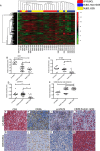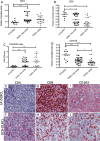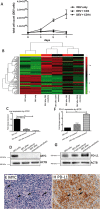A strong host response and lack of MYC expression are characteristic for diffuse large B cell lymphoma transformed from nodular lymphocyte predominant Hodgkin lymphoma
- PMID: 27708232
- PMCID: PMC5342154
- DOI: 10.18632/oncotarget.12363
A strong host response and lack of MYC expression are characteristic for diffuse large B cell lymphoma transformed from nodular lymphocyte predominant Hodgkin lymphoma
Abstract
Nodular lymphocyte predominant Hodgkin lymphoma (NLPHL) is an indolent lymphoma, but can transform into diffuse large B cell lymphoma (DLBCL), showing a more aggressive clinical behavior. Little is known about these cases on the molecular level. Therefore, the aim of the present study was to characterize DLBCL transformed from NLPHL (LP-DLBCL) by gene expression profiling (GEP). GEP revealed an inflammatory signature pinpointing to a specific host response. In a coculture model resembling this host response, DEV tumor cells showed an impaired growth behavior. Mechanisms involved in the reduced tumor cell proliferation included a downregulation of MYC and its target genes. Lack of MYC expression was also confirmed in 12/16 LP-DLBCL by immunohistochemistry. Furthermore, CD274/PD-L1 was upregulated in DEV tumor cells after coculture with T cells or monocytes and its expression was validated in 12/19 cases of LP-DLBCL. Thereby, our data provide new insights into the pathogenesis of LP-DLBCL and an explanation for the relatively low tumor cell content. Moreover, the findings suggest that treatment of these patients with immune checkpoint inhibitors may enhance an already ongoing host response in these patients.
Keywords: T cell/histiocyte rich large B cell lymphoma; diffuse large B cell lymphoma; gene expression profiling; host response; nodular lymphocyte predominant Hodgkin lymphoma.
Conflict of interest statement
The authors report no potential conflict of interest.
Figures




References
-
- Swerdlow SH, International Agency for Research on Cancer, World Health Organization . WHO classification of tumours of haematopoietic and lymphoid tissues. 4. Vol. 439 Lyon, France: International Agency for Research on Cancer; 2008.
-
- Rosenwald A, Wright G, Chan WC, Connors JM, Campo E, Fisher RI, Gascoyne RD, Muller-Hermelink HK, Smeland EB, Giltnane JM, Hurt EM, Zhao H, Averett L, et al. The use of molecular profiling to predict survival after chemotherapy for diffuse large-B-cell lymphoma. N Engl J Med. 2002;346:1937–47. doi: 10.1056/NEJMoa012914. - DOI - PubMed
-
- Young RM, Wu T, Schmitz R, Dawood M, Xiao W, Phelan JD, Xu W, Menard L, Meffre E, Chan WC, Jaffe ES, Gascoyne RD, Campo E, et al. Survival of human lymphoma cells requires B-cell receptor engagement by self-antigens. Proc Natl Acad Sci USA. 2015;112:13447–54. doi: 10.1073/pnas.1514944112. - DOI - PMC - PubMed
-
- Hans CP, Weisenburger DD, Greiner TC, Gascoyne RD, Delabie J, Ott G, Müller-Hermelink HK, Campo E, Braziel RM, Jaffe ES, Pan Z, Farinha P, Smith LM, et al. Confirmation of the molecular classification of diffuse large B-cell lymphoma by immunohistochemistry using a tissue microarray. Blood. 2004;103:275–82. doi: 10.1182/blood-2003-05-1545. - DOI - PubMed
MeSH terms
Substances
LinkOut - more resources
Full Text Sources
Other Literature Sources
Medical
Molecular Biology Databases
Research Materials

